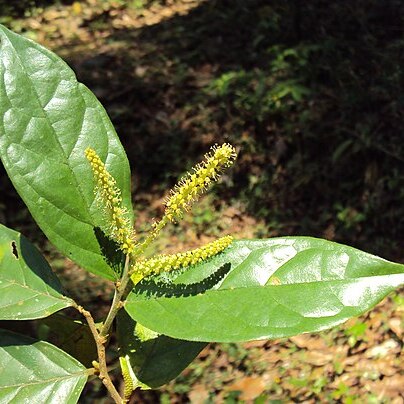Shrubs or trees up to 15(-20) m tall; young branches pubescent, glabrescent. Stipules linear to lanceolate, 2-7(-13) × 0.5-1.5 mm, pubescent, caducous or persistent; petiole 2-10(-20) mm, pubescent, glabrescent; leaf blade elliptic, oblong, lanceolate, or linear, more rarely slightly ovate or obovate, (1.5-)3-25 × (0.4-)1.5-10 cm, membranous to leathery, glabrous except midvein and lateral veins pubescent on one or both surfaces, sometimes pubescent along margin, rarely abaxially slightly pubescent throughout, shiny and drying olive green to grayish green on both sides, often lighter abaxially, base acute or obtuse, rarely rounded, apex acuminate, acute, or obtuse, mucronate or not; domatia sometimes present; major veins impressed or flat adaxially, lateral veins 6-12 pairs, tertiary venation weakly percurrent or reticulate. Inflorescences axillary or terminal, males 1-13 cm, unbranched to 10(-40)-branched, females 1-10 cm, unbranched to 6-branched, fruiting 2.5-20 cm, axes glabrous or pubescent. Male flowers sessile to pedicellate; pedicels to 1.5(-2) mm, glabrous to pubescent; calyx shallowly cup-shaped; sepals 3 or 4(or 5), free to fused for ca. 1/2 of their length, 0.5-0.8 mm, broadly ovate or rounded to obtuse, rarely acute, pubescent to glabrous outside, glabrous inside but often with long hairs at base, margin usually glandular-fimbriate to lacerate; disk cushion-shaped, fully or partially enclosing bases of filaments and pistillode or annular and 3-5-lobed, lobes extending inward between filaments to pistillode, glabrous, very rarely with some hairs; stamens 3-5(or 6), 1-2 mm; rudimentary ovary clavate, hemispheric, or terete, apex obtuse, sometimes obscurely lobed. Female flowers: pedicel 0.2-1.5 mm, fruiting 1-4 mm, glabrous to pubescent; calyx cup-shaped; sepals 3-5(or 6), 0.3-1 mm, triangular to ovate, otherwise as in males; disk glabrous, very rarely with some hairs; ovary glabrous, very rarely with some hairs; stigmas 2-6. Drupes ellipsoid, terete, (3-)5-6(-8) × 2.5-4(-6) mm, glabrous; styles terminal, very rarely slightly subterminal.
More
A shrub or small tree. It is erect and open branched and the twigs are dull brown and slender. The leaves are many and oblong. They are paler green underneath and smooth and shiny clear on top. The leaves are in 2 rows. They are narrowly oval. The male and female flowers are in groups but the female ones are larger. The fruit are small, egg shaped and red when ripe. They finally turn black. They are crowned by a style.


